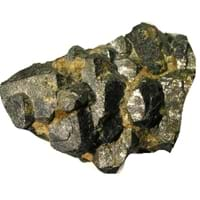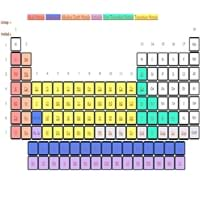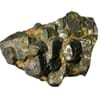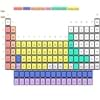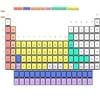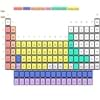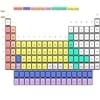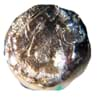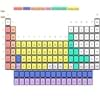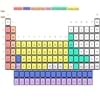Actinium vs Nihonium
Periodic Table
Symbol
Ac
Nh
Group Number
Not Available
13
5
Period Number
7
7
Block
f block
p block
Element Family
Actinide
Probably Post-Transition
CAS Number
7440348
99+
54084707
6
Space Group Name
Fm_ 3m
Not Available
Space Group Number
225.00
2
194.00
5
Facts
Interesting Facts
Not Available
Not Available
Sources
Obtained by Treating Radium with Neutrons, Ores of metals
Synthetically Produced
History
Who Discovered
Friedrich Oskar Giesel
Joint Institute for Nuclear Research and Lawrence Livermore National Laboratory
Discovery
In 1902
In 2003
Abundance
Uses
Uses & Benefits
- Actinium metal has a great source of alpha rays but it is hardly used outside research purpose.
- Currently known uses of Ununtrium metal are limited to research purpose only.
Industrial Uses
NA
NA
Medical Uses
NA
NA
Other Uses
Alloys, Nuclear Research, Research Purposes
Research Purposes
Biological Properties
Toxicity
Toxic
Unknown
Present in Human Body
No
No
In Blood
0.00 Blood/mg dm-3
37
Not Available
In Bone
0.00 p.p.m.
36
Not Available
Physical Properties
Melting Point
1,227.00 °C
38
430.00 °C
99+
Boiling Point
3,200.00 °C
26
1,130.00 °C
99+
Appearance
Physical State
Solid
Solid
Color
Silvery White
Unknown
Luster
NA
Unknown Luster
Hardness
Speed of Sound
Not Available
Not Available
Optical Properties
Allotropes
No
No
α Allotropes
Not Available
Not Available
β Allotropes
Not Available
Not Available
γ Allotropes
Not Available
Not Available
Chemical Properties
Chemical Formula
Ac
Nh
Isotopes
Known Isotopes
29
10
7
31
Electronegativity
Pauling Electronegativity
1.10
99+
Not Available
Allred Rochow Electronegativity
1.00
36
Not Available
Electropositivity
Pauling Electropositivity
2.90
10
Not Available
Ionization Energies
1st Energy Level
499.00 kJ/mol
99+
704.90 kJ/mol
34
2nd Energy Level
1,170.00 kJ/mol
99+
2,238.50 kJ/mol
7
3rd Energy Level
1,900.00 kJ/mol
99+
3,023.30 kJ/mol
26
4th Energy Level
4,700.00 kJ/mol
23
4,351.50 kJ/mol
29
5th Energy Level
Not Available
5,692.60 kJ/mol
28
Electrochemical Equivalent
2.82 g/amp-hr
18
Not Available
Electron Work Function
Not Available
Not Available
Other Chemical Properties
Ionization, Radioactive Isotopes, Radioactivity, Solubility
Chemical Stability, Ionization
Atomic Properties
Atomic Number
89
29
113
5
Electron Configuration
[Rn] 6d1 7s2
[Rn] 5f14 6d10 7s2 7p1
Crystal Structure
Face Centered Cubic (FCC)
Not Known
Crystal Lattice
FCC-Crystal-Structure-of-Actinium.jpg#100
Unknown-Crystal-Structure-of-Ununtrium.jpg#100
Atom
Number of Protons
89
29
113
5
Number of Neutrons
138
16
150
11
Number of Electrons
89
29
113
5
Radius of an Atom
Atomic Radius
195.00 pm
7
Not Available
Atomic Weight
227.00 amu
25
286.00 amu
4
Atomic Volume
22.54 cm3/mol
11
Not Available
Adjacent Atomic Numbers
Valence Electron Potential
38.60 (-eV)
99+
Not Available
Lattice Constant
567.00 pm
8
Not Available
Lattice Angles
π/2, π/2, π/2
NA
Lattice C/A Ratio
Not Available
Not Available
Mechanical Properties
Density
Density At Room Temperature
10.00 g/cm3
37
16.00 g/cm3
19
Tensile Strength
Not Available
Not Available
Viscosity
Not Available
Not Available
Vapor Pressure
Elasticity properties
Poisson Ratio
Not Available
Not Available
Other Mechanical Properties
NA
Unknown
Magnetic Properties
Magnetic Characteristics
Specific Gravity
10.07
28
Not Available
Magnetic Ordering
Paramagnetic
Unknown
Electrical Properties
Thermal Properties
Specific Heat
0.12 J/(kg K)
40
Not Available
Molar Heat Capacity
27.20 J/mol·K
18
Not Available
Thermal Conductivity
12.00 W/m·K
99+
Not Available
Critical Temperature
Not Available
Not Available
Thermal Expansion
Not Available
Not Available
Enthalpy
Enthalpy of Atomization
301.00 kJ/mol
36
Not Available
Standard Molar Entropy
56.50 J/mol.K
25
Not Available
|
||
|
||
|
